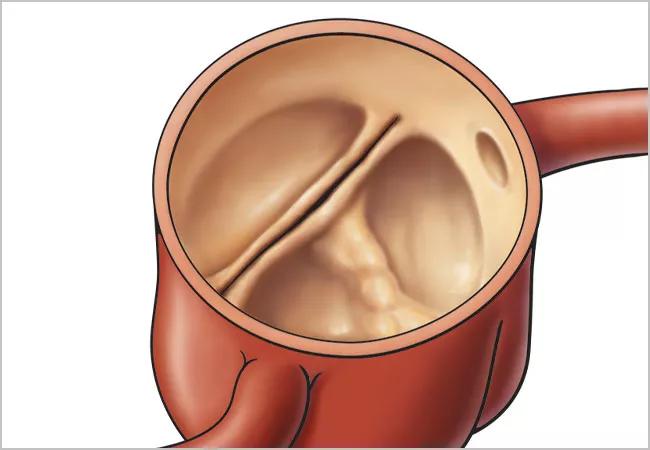Large cohort analysis underscores key role of multimodal imaging

Surgical repair or replacement of a bicuspid aortic valve (BAV) significantly lowers rates of death and/or dissection in BAV patients, particularly when surgery is done in conjunction with prophylactic ascending aorta replacement. So concludes a large Cleveland Clinic analysis recently published in the Journal of Thoracic and Cardiovascular Surgery.
Cleveland Clinic is a non-profit academic medical center. Advertising on our site helps support our mission. We do not endorse non-Cleveland Clinic products or services. Policy
“Long-term outcomes in terms of death or dissection were significantly better for BAV patients who underwent surgery than for those who did not undergo surgery, and they were in fact similar to those for a normal, age- and gender-matched population,” says principal author Milind Desai, MD, a Cleveland Clinic cardiovascular imaging specialist.
The study also appears to shed light on the controversial question of the most appropriate threshold of aortic measurement at which preventive surgical intervention for BAV is indicated.
In previous research, Cleveland Clinic surgeons reported excellent short- and long-term outcomes from valve repair in BAV patients with aortic insufficiency and from valve replacement in BAV patients with symptomatic aortic stenosis and those whose valves could not be repaired. This new study sought to determine the impact of surgical intervention on long-term outcomes of BAV patients who developed AV complications and/or had concomitant aortopathy.
Prior studies have shown that young adults with BAV have a high rate of cardiovascular events (33 percent). Studies have also shown the prevalence of concomitant aortopathy to be as high as 80 percent.
Data were lacking on the long-term outcomes of these patients as well as on optimal AV size for preventive surgical intervention. The researchers employed an innovative multimodal imaging approach to address these issues.
They analyzed a cohort of 1,890 consecutive patients with BAV seen at Cleveland Clinic from 2003 through 2007. All had undergone transthoracic echocardiography for diagnostic evaluation. Those found to have aortic root or ascending aortic dimensions greater than or equal to 4 cm had been sent for chest multidetector computed tomography (MDCT) or aortic magnetic resonance angiography (MRA). Aortic dimensions ≥4 cm on MDCT or MRA were considered abnormal and classified as mildly dilated, mildly aneurysmal or severely aneurysmal.
In this BAV cohort, the researchers demonstrated that 35 percent also had a dilated aortic root, and 42 percent had a dilated ascending aorta. “It really shows that you can’t just look at the valve; you have to look at the aorta too,” says Dr. Desai.
Forty-nine percent of patients in the overall cohort underwent BAV-related surgery during the study’s follow-up period, with 73 percent having their operation within one year of initial evaluation at Cleveland Clinic. Of these surgical patients, 36 percent had isolated AV surgery, 3 percent had isolated ascending aorta replacement and the remainder had a combination procedure (AV surgery plus either ascending aorta grafting, CABG or both).
Nearly three-quarters (74 percent) of patients in the overall cohort were followed for 7 or more years. At 8.1 ± 2 years of follow-up, primary events had occurred in 9 percent and included cardiovascular death (n = 120), documented noncardiac death (n = 49) and type A dissection (n = 2).
Among the 918 patients who underwent BAV-related surgery, 1.4 percent died (n = 4) or suffered a stroke (n = 9) in the immediate postoperative period (≤ 30 days).
Upon multivariate analysis, factors associated with an elevated primary event rate were increasing age, increasing aortic root size, decreasing left ventricular ejection fraction and hyperlipidemia.
Notably, BAV-related cardiovascular surgery was associated with a significantly reduced primary event rate (hazard ratio = 0.44; 95% CI, 0.31-0.70).
In patients with an ascending aorta ≥4.5 cm as determined by MDCT or MRA, concomitant aorta replacement surgery was associated with freedom from primary events.
“Clearly, increasing aortic size is a risk for adverse outcomes,” says Dr. Desai. “This highlights the need to obtain precise aortic dimensions — which echocardiography may or may not provide. In this respect, additional tomographic imaging can be very helpful.”
As a result of this finding, Cleveland Clinic now routinely performs a CT or MRA in these patients.
Whereas the addition of aortic dimensions added incremental prognostic utility to the use of BAV risk scores, the ultimate long-term gain was achieved with aggressive aortic replacement surgery. “In an experienced center like Cleveland Clinic, outcomes are better with surgery,” says Dr. Desai.
“This second paper by our group builds on previous studies showing that when the aorta gets above 5 cm in diameter, particularly in the aortic root, the risk of aortic dissection increases markedly in patients with bicuspid valves,” notes study co-author and cardiothoracic surgeon Lars Svensson, MD, PhD, Chair of Cleveland Clinic’s Miller Family Heart & Vascular Institute.
“Furthermore, the ratio of aortic cross-sectional area to height is an even better predictor, based on a study of 1,181 patients we just published in Annals of Thoracic Surgery,” Dr. Svensson continues. “Among the patients in that study who underwent aortic surgery for aortic aneurysms associated with bicuspid valves, mortality was only 0.25 percent and the stroke rate was only 0.75 percent.”

Surprise findings argue for caution about testosterone use in men at risk for fracture

Findings support emphasis on markers of frailty related to, but not dependent on, age
![GettyImages-1252287413 [Converted]](https://assets.clevelandclinic.org/transform/StoryPanel/350804b2-f1e4-4d97-a277-9629cf45af3e/23-HVI-4120348_redlining_650x450_jpg?w=3840&q=75)
Large database study reveals lingering health consequences of decades-old discrimination

Additional analyses of the two trials presented at 2023 ESC Congress

Prospective SPIRIT-HCM trial demonstrates broad gains over 12-month follow-up

An ACC committee issues recommendations to accelerate sluggish progress

Review of our recent experience shows it’s still a safe option

Machine learning may improve risk prediction and guide therapy